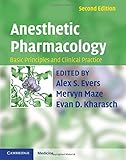Anesthetic pharmacology / edited by Alex S. Evers, Mervyn Maze, Evan D. Kharasch.
Tipo de material: TextoSeries Cambridge medicineEditor: Cambridge ; New York, NY : Cambridge University Press, c2011Edición: 2nd edDescripción: xv, 1194 páginas : ilustracionesTipo de contenido:
TextoSeries Cambridge medicineEditor: Cambridge ; New York, NY : Cambridge University Press, c2011Edición: 2nd edDescripción: xv, 1194 páginas : ilustracionesTipo de contenido: - texto
- no mediado
- volumen
- 0521896665
- 9780521896665
- 615.781 A579 2011
| Tipo de ítem | Biblioteca actual | Colección | Signatura topográfica | Estado | Notas | Fecha de vencimiento | Código de barras | Reserva de ítems | |
|---|---|---|---|---|---|---|---|---|---|
| Reserva Libro | Biblioteca Central | Reserva Colección General | 615.781 A579 2011 (Navegar estantería(Abre debajo)) | Disponible | GEN | 33409002734105 |
Incluye bibliografía.
37. Anticonvulsant and antipsychotic drugs; 38. Neuromuscular blocking agents; 39. Reversal drugs; 40. Sympathomimetics and vasoconstrictors; 41. Parasympathomimetic and parasympatholytic drugs; 42. [beta]-blockers and other adrenergic receptor antagonists; 43. Antiarrhythmic agents; 44. Positive inotropic drugs; 45. Vasodilators (incl. ACE inhibitors and NO); 46. Calcium channel blockers; 47. Bronchodilators; 48. Pulmonary vasodilators; 49. Drugs acting via the kidney; 50. Fluids and electrolytes as pharmacologic agents; 51. Corticosteroids and anti-inflammatory agents; 52. Anti-rejection drugs and immunosuppressants; 53. Antimotility and antisecretory agents; 54. Antiemetics; 55. Insulin and anti-hyperglycemic agents; 56. Nutritional elements of management; 57. Agents affecting coagulation and platelet function; 58. Obstetrical adjuvants and obstetric pharmacology; 59. Antimicrobial therapy; Part IV. Clinical Application and Anesthesia Practice (Evidence Based, Rational Drug Selection, Management): 60. Pre-operative management; 61. Induction of anesthesia; 62. Maintenance and emergence from anesthesia; 63. Management of sedation, analgesia and delirium; 64. Post-operative analgesia; 65. Control of blood pressure and vascular tone; 66. Cardiac protection and pharmacologic management of myocardial ischemia; 67. Management of patients with chronic alcohol or drug use; 68. Drug allergy and treatment; 69. Special populations -- pediatric; 70. Special populations -- geriatric; 71. Emerging concepts: neuroprotection and neurotoxicity; Index.
Machine generated contents note: Preface to the first edition; Preface to the second edition; Part I. Principles of Drug Action: 1. Pharmacodynamic principles of drug action; 2. G protein coupled receptors; 3. Other signalling pathways; 4. Signal transduction mechanisms: ion channels; 5. Principles of pharmacokinetics; 6. Principles of drug transformation; 7. Drug transport and transporters; 8. Target controlled infusions and closed loop administration; 9. Alternate routes of drug administration; 10. Principles of pharmacogenetics; 11. Pharmacodynamic drug interactions in anesthetic practice; 12. Pharmacoeconomics; Part II. Physiologic Substrates of Drug Action: 13. Sleep and consciousness; 14. Synaptic transmission; 15. Memory, learning and cognition; 16. Mechanisms of pain transmission and transduction; 17. Generation and propagation of action potentials; 18. Neuromuscular junction; 19. Vascular reactivity; 20. Cardiac rhythm; 21. Myocardial performance; 22. Autonomic function; 23. Physiology of immunity and inflammation; Part III. Essential Drugs in Anesthetic Practice: 24. Mechanisms of anesthetic action; 25. Pharmacokinetics of inhaled anesthetics; 26. Clinical pharmacology of inhaled anesthetics; 27. Pharmacokinetics of intravenous anesthetics; 28. Clinical pharmacology of intravenous anesthetics; 29. Benzodiazepines; 30. [alpha]-2 Agonists and other sedatives and amnestics; 31. Mechanisms of action of opioids; 32. Pharmacokinetics of opioids; 33. Clinical pharmacology of opioids; 34. Nonsteroidal anti-inflammatory drugs; 35. Other ion channel and receptor ligands for analgesia; 36. Local anesthetics;
No hay comentarios en este titulo.
